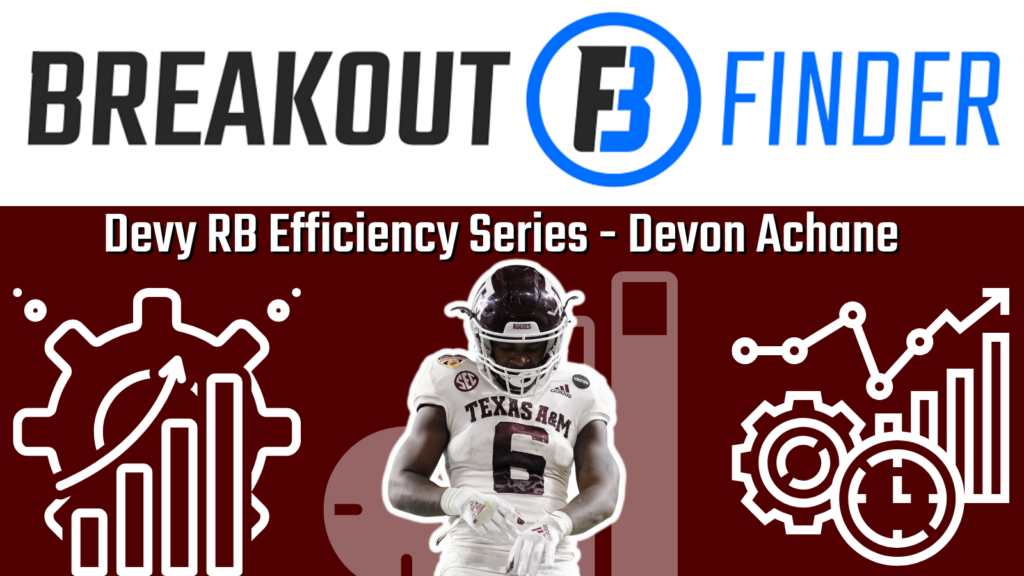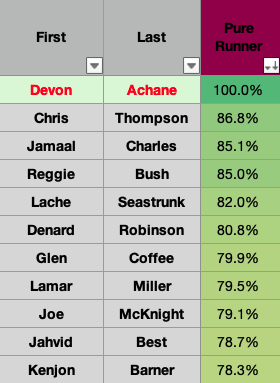This article is part of a series in which I evaluate current college running backs solely on their ability to run the ball. I previously did the same sort of analysis focused on the 2022 rookie running back class, and you can find those articles, as well as explanations of my methodology, here and here. Otherwise, feel free to skip to the player-focused analysis below.

Texas A&M’s Devon Achane was a four-star player in the recruiting class of 2020. And he’s been excellent since joining the Aggies that year. As a true freshman on an A&M squad that went 9-1 and finished as the No. 4-ranked team in the country, Achane posted an 18.9-percent Dominator Rating; a 72nd-percentile mark for first-year college runners who would go on to be drafted since 2007. He was just as good in 2021, posting a 26.3-percent (73rd-percentile) Dominator Rating on another above-average SEC team. All that was done while sharing the field with Isaiah Spiller, one of the best backs in the 2022 class.
Achane is also a super dynamic athlete with near-world class speed. He finished among the 15 fastest men in the NCAA in both the 100 meters and 200 meters last season.
Let’s see how his rushing efficiency profile matches up to his production and raw athletic ability.
The Metrics
Through two seasons in College Station, Devon Achane has handled 173 carries; good for a per-game carry rate in just the 26th-percentile. On that volume and relative to teammates who averaged a collective 3.94-star rating (82nd-percentile) as high school recruits, he has posted an incredible 1.79 (91st-percentile) YPC+ mark. Especially impressive given the circumstances he operates in. Historical data indicates that we would expect an NFL-quality running back with the same volume and playing with the same quality of teammates to average 0.23 yards per carry greater than those teammates. He is outdoing that expected YPC+ by a ridiculous 1.56.
It’s reasonable to assume that, as a speedy, 185-pound guy who catches the ball and is good out in space, Achane is running into light fronts on passing downs while the other backs on the team are churning out tough yardage against defenses more geared up to stop the run. Based on box count data, however, that is simply not the case.
The boxes that Achane has run the ball into on his carries have been 0.15 defenders heavier than those faced by other Aggie running backs; a discrepancy working against his favor to a 77th-percentile degree.
Given his team-relative performance against those defensive fronts, Achane has produced a 138.4-percent (92nd-percentile) Box-Adjusted Efficiency Rating.
More Metrics
Another reasonable assumption is that, as a speedy, 185-pound guy who catches the ball and is good out in space, Devon Achane‘s efficiency is largely fueled by long runs. He is indeed a big-play runner, evidenced by a 38.5-percent (82nd-percentile) Breakaway Conversion Rate. However, his play-to-play consistency suggests that this assumption also misses the mark.
Success Rate is a metric that assigns a binary success/failure tag to each rushing attempt based on whether it gains a requisite amount of yards given down and distance. Given the box counts, Achane has succeeded on a much greater percentage of his carries than other A&M backs. His 12.7-percent (96th-percentile) Relative Success Rate is higher than the marks from every back in the 2022 draft class. He is both incredibly efficient and incredibly consistent on a down-to-down basis relative to the output of the other players operating within the same offensive environment.
Rushing Efficiency Score and Comps
My process combines percentile scores in the above metrics (in addition to adjustments for overall team quality and strength of opponent) to generate composite scores that quantify a player’s overall rushing efficiency profile. In a composite that uses BAE Rating and RSR, Devon Achane earns a 92.6 out of 100. In a composite that uses the non-box count-related metrics, he earns a 81.0.
Using the same metrics that go into those rushing efficiency composites (in addition to physical measurables), I am also able to generate similarity scores between current and past prospects as a way of formulating comps. Using historical college height and weight data for eventual NFL running backs, I project Achane to be 5-9 and 197-pounds at his eventual Combine weigh-in. If he runs a 4.40 at that size (and he’s probably faster than that), the following players will be his ten closest comps from a “pure runner” perspective:

Chris Thompson would be a pretty nice overall comp if his best season of production wasn’t worse than Achane’s true freshman production. Therefore, we should view Achane as being in a completely different tier of prospect as a guy like Thompson. Forgive me for blaspheming by suggesting that the next two guys on the comps list better represent the kind of player we should expect him to be.
Last Word
Devon Achane has been very productive and uber efficient relative to talented players on a good Texas A&M team through two seasons. His versatile skillset and athletic ability combine to make him one of the best running backs in college football. Guys with his production and on-field profiles simply become good NFL players. If you’re fading him because he’s small, I hope you’re retroactively keeping that same energy with Jamaal Charles. He was too small, too.
